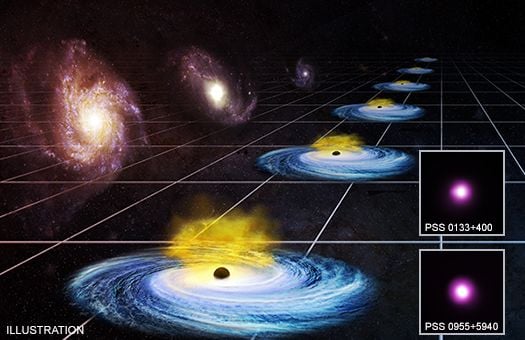Staring into the Darkness
The expansion of our universe is accelerating. Every single day, the distances between galaxies grows ever greater. And what's more, that expansion rate is getting faster and faster - that's what it means to live in a universe with accelerated expansion. This strange phenomenon is called dark energy, and was first spotted in surveys of distant supernova explosions about twenty years ago. Since then, multiple independent lines of evidence have all come to the same morose conclusion: the universe is getting fatter and fatter faster and faster.
Still, what the heck is causing is? What is dark energy? Various ideas abound for potential causes. Perhaps it's an illusion, and our understanding of gravity is simply wrong at these vast scales. Perhaps a somewhat-mysterious field permeates all of spacetime, which drives the amplification of the distances between galaxies throughout the universe.
By far the simplest explanation is that dark energy is simply there. A simple constant of nature that appears in the equations of General Relativity, which is the fundamental framework for how we understand matters cosmological. It has no explanation and no cause. Like any other constant of nature, it's just a part of fundamental reality.
While this explanation isn't entirely satisfying, it does explain all the available data so far.
Tapping the Quasar's Energy
And the data are simply this: it appears that dark energy's strength has remained absolutely constant throughout cosmic time. It's there, present, unchanging in both time and space.
Maybe.
One of the biggest challenges of studying the nature of dark energy is that we don't have a complete picture of the expansion history of the universe. Instead, we have what amounts to cosmological "bookends" - we can study the expansion at relatively recent times using Type 1a supernova, and we know very precisely the state of the universe when it was only 380,000 years old via the cosmic microwave background.
We don't have a very clear picture of what the universe was up to in between, but recently a pair of researchers are trying to change that by examining the light from distant quasars. These quasars are monstrously bright objects, powered by the gravitational compression of material as its squeezes itself to fit inside giant black holes. Quasars are by far the most powerful engines in the universe, making them excellent candidates for peering deep into cosmic history in between the bookends.
The central challenge, however, is that you're never quite sure how far away a given quasar is. If one is brighter than another, is the first one closer...or just brighter? Without a way to disentangle these, you can't get a firm distance, which means you can't measure the expansion of the universe since the time that quasar emitted its light.
However, the researchers applied a new trick by comparing two different kinds of light emitted by the quasars. The first kind is ultraviolet emitted from the in-falling material itself. The second is harder X-rays created from the ultraviolet radiation getting boosted to higher energies from even more surrounding gas. By comparing these two emission sources, the researchers can reveal the true brightness of each quasar and thus know their distances.
Big Rip, Big Deal
And the researchers found that, according to their preliminary results, dark energy was weaker in the past. That means it's not constant - it's evolving and changing, and growing stronger with time. If this result holds up (and that's a big if) then our simplest explanation of dark energy will have to be tossed out the window in favor of something more complicated. Which is actually a good thing - a changing dark energy could give us the clues we need to explore new areas of physics.
But this result also paints a more sombre picture of the future of the universe. If dark energy remains constant, then stars will continue to shine for tens of trillions of years as galaxies gently drift away from each other. But if dark energy grows stronger with time, then its repulsive force becomes overwhelming, not only driving apart galaxies but also ripping apart the galaxies themselves.
And solar systems.
And planets.
And molecules.
How long will it take for this "big rip" scenario to play out? It depends on just how quickly dark energy ramps up, but it could be in as little as a few billion years. Which, cosmologically speaking, isn't that long.
Read more: "Cosmological constraints from the Hubble diagram of quasars at high redshifts"
 Universe Today
Universe Today

